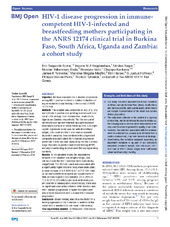| dc.contributor.author | Some, Nagaonle Eric | en_US |
| dc.contributor.author | Engebretsen, Ingunn Marie S. | en_US |
| dc.contributor.author | Nagot, Nicolas | en_US |
| dc.contributor.author | Meda, Nicolas | en_US |
| dc.contributor.author | Vallo, Roselyne | en_US |
| dc.contributor.author | Kankasa, Chipepo | en_US |
| dc.contributor.author | Tumwine, James K | en_US |
| dc.contributor.author | Singata, Mandisa | en_US |
| dc.contributor.author | Harper, Kim | en_US |
| dc.contributor.author | Hofmeyr, G. Justus | en_US |
| dc.contributor.author | Perre, Philippe van de | en_US |
| dc.contributor.author | Tylleskär, Thorkild | en_US |
| dc.date.accessioned | 2019-04-12T12:32:24Z | |
| dc.date.available | 2019-04-12T12:32:24Z | |
| dc.date.issued | 2018 | |
| dc.identifier.issn | 2044-6055 | |
| dc.identifier.uri | https://hdl.handle.net/1956/19325 | |
| dc.description.abstract | Objective: We have assessed HIV-1 disease progression among HIV-1-positive mothers in relation to duration of any or exclusive breast feeding in the context of ANRS 12174 trial. Methods: The analysis was completed on 203, 212, 272 and 529 HIV-1-positive and lactating mothers with CD4 count >350 cells/µL from Burkina Faso, South Africa, Uganda and Zambia, respectively. The trial compared lamivudine and lopinavir/ritonavir as a peri-exposure prophylaxis during a 50-week follow-up time. A multiple logistic regression model was run with the mothers’ weight, CD4 count and HIV-1 viral load as separate dependent variables, then combined into a dependent composite endpoint called HIV-1 disease progression where HIV-1 viral load was replaced by the HIV-1 clinical stage. Exclusive or predominant breast feeding (EPBF) and any breastfeeding duration were the key explanatory variables. Results: In the adjusted model, the associations between EPBF duration and weight change, CD4 cell count and the HIV-1 viral load were consistently insignificant. The CD4 cell count was associated with a significantly higher mothers’ body mass index (BMI; a mean increase of 4.9 (95% CI 2.1 to 7.7) CD4 cells/µL per each additional kilogram per square metre of BMI) and haemoglobin concentration (19.4 (95% CI 11.4 to 27.4) CD4 cells/µL per each additional gram per decilitre of haemoglobin concentration). There was no significant association between EPBF duration and HIV-1 disease progression. A higher education level was a factor associated with a slower HIV-1 disease progression. Conclusion: Breast feeding was not a risk factor for a faster progression of HIV-1 disease in mothers of this cohort with a baseline CD4 cell count >350 cells/µL. | en_US |
| dc.language.iso | eng | eng |
| dc.publisher | BMJ | eng |
| dc.rights | Attribution CC BY-NC | eng |
| dc.rights.uri | http://creativecommons.org/licenses/by-nc/4.0/ | eng |
| dc.title | HIV-1 disease progression in immune-competent HIV-1-infected and breastfeeding mothers participating in the ANRS 12174 clinical trial in Burkina Faso, South Africa, Uganda and Zambia: a cohort study | en_US |
| dc.type | Peer reviewed | |
| dc.type | Journal article | |
| dc.description.version | publishedVersion | en_US |
| dc.rights.holder | Copyright 2018 The Author(s) | |
| dc.source.articlenumber | e019239 | |
| dc.identifier.doi | https://doi.org/10.1136/bmjopen-2017-019239 | |
| dc.identifier.cristin | 1662623 | |
| dc.source.journal | BMJ Open | |
| dc.source.40 | 8 | |

